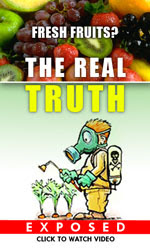How the USDA Organic Standard Allowed Fluoride to Contaminate the Organic Label
![]() April McCarthy, Prevent Disease
April McCarthy, Prevent Disease
Waking Times
There are many reasons to no longer trust the USDA organic label, however history gives a good lesson on why you should never confide in this government agency. The original standards proposed in 1997 by the US Department of Agriculture’s (USDA) revised rule on National Organic Standards (NOS) was first finalized in 2000. The standards first proposed included proposals to use sewage sludge, irradiation, antibiotics in livestock, and genetically modified organisms. The USDA withdrew the proposal after receiving over 275,000 comments from the public– the most comments received on any US agency proposal in history. In the final NOS, the four practices listed above were left out, but unfortunately, despite opposition, those public concerns about fluoride were ignored. To this day, the organic standards allow the use of the toxic sodium fluoride in organic agriculture.
Fluoride is a persistent and non-degradable poison that accumulates in soil, plants, wildlife, and humans. Many organic farmers may be unaware that this highly toxic substance has been allowed for use in the NOS, because its presence is hidden. However, it is there:
| – As Sodium Fluoride tucked away in the US EPA List 4 Inerts (“Inerts which have sufficient data to substantiate they can be used safely in pesticide products, according to EPA.”), which are allowed for use in the NOS.- In Bone Meal (which can contain 1000 ppm – or more- fluoride), also included in US EPA List 4 Inerts (“Inerts generally regarded as safe, i.e., corn cobs and cookie crumbs,” according to EPA).- Because fluoride is “pesticidally active” and “of toxicological concern”, it never should have been on EPA’s List 4 Inerts (nonactive ingredients). – Section 6508 (c)1 of the Rule says producers shall not use “natural poisons such as arsenic or lead salts that have long-term effects and persist in the environment.” Fluoride is in this category. – The broad spectrum of fluoride’s toxic abilities makes it especially inappropriate for use in sustainable, organic agriculture. |
To call sodium fluoride an “inert” is Orwellian and defies one of the NOS’s stated principles: producers shall not use “natural poisons such as arsenic or lead salts that have long-term effects and persist in the environment.” Fluoride is clearly in this category. Sadly, the use of fluoride in organic farming could undermine the public’s confidence and safety in organic food – both here and abroad. This will become more obvious as the movement against fluoridation of public water picks up momentum worldwide. As it does more and more people will be asking questions about fluoride levels in their food. Unlike the List of Inerts, fluoride levels in organic food cannot be hidden.
* The Agency for Toxic Substances and Disease Registry (ATSDR) stated in 1993: “Existing data indicate that subsets of the population may be unusually susceptible to the toxic effects of fluoride and its compounds. These populations include the elderly, people with deficiencies of calcium, magnesium, and/or vitamin C, and people with cardiovascular and kidney problems… Because fluoride is ubiquitous in food and water, the potential for human exposure is substantial (ATSDR, p 112, 153).”
* In 1998, a fluoride study published in Brain Research reported damage to rat kidneys and brain at very low doses. Rats were given 1 ppm fluoride in doubly distilled and de-ionized water for 52 weeks. In other words they were given the same levels as we get in fluoridated water, albeit without the other ions present in tap water. One group of rats was given aluminum-fluoride (AlF3) and another, sodium fluoride (NaF). In both cases amyloid deposits were found in the rat brains. Amyloid deposits are tangles in the brain and are associated with Alzheimer’s Disease and other forms of dementia. Scientists do not know why they form. The rats in the control did not have them. The authors of the study speculate that fluoride enables aluminum to cross the blood brain barrier (Varner et al). This paper has caused quite a stir in regulatory circles and has prompted both the NIEHS and the EPA to nominate aluminum fluoride for comprehensive study by the National Toxicology Program.
* In 1994, a FDA researcher published results from a study that found an association between residence in counties with high fluoride concentrations in drinking water (3 ppm) with decreased birth rates. The author raised the question “whether public health concerns and toxicologic research should not shift their focus from the isolated intake from fluoridated water to the potential toxicity of the total fluoride intake (Freni).” This suggestion is important, because surprisingly, a great deal of the promotion of fluoridation in the US has centered on the concentration of fluoride in drinking water and has been very cavalier about the total dose of fluoride we get from ALL sources.
 The USDA organic label is supposed to protect the consumer against GMOs and avoidable chemical exposures, but the sobering fact is that even USDA-certified infant formula manufacturers are not only being allowed to use a pesticide in their formulas, but are advertising them as a ‘healthy’ mineral to unsuspecting consumers.
The USDA organic label is supposed to protect the consumer against GMOs and avoidable chemical exposures, but the sobering fact is that even USDA-certified infant formula manufacturers are not only being allowed to use a pesticide in their formulas, but are advertising them as a ‘healthy’ mineral to unsuspecting consumers.
Due to its high toxicity, fluoride has long been used as a pesticide. In the United States, there are currently two fluoride-based pesticides that are allowed to be sprayed on food. These are: cryolite and sulfuryl fluoride.
The main way people are exposed to fluoride from the pesticide cryolite is through consumption of grape products, particularly white grapes, grown in the U.S. This is because cryolite use is widespread among U.S. vinyards.
Cryolite is also allowed to be added to the following products (although it is unclear how many producers actually do so, and what the resulting fluoride levels are):
- Apricot, Broccoli, Brussels Sprout, Cabbage, Cauliflower, Citrus fruit, Collards, Eggplant, Kale, Kiwifruit, Kohlrabi, Lettuce, Melon, Nectarine, Peach, Pepper, Plum, Pumpkin, Squash (summer & winter), Tomato, and a number of Berries (Blackberry, Blueberry (huckleberry) Boysenberry, Cranberry, Dewberry, Loganberry, Raspberry, Strawberry, Youngberry).
Sodium Fluoride (NaF)
Sodium fluoride is used as a rodenticide and insecticide (mainly for roaches and ants), as a disinfectant for fermentation apparatus in breweries and distilleries, in wood preservation, and in rimmed steel manufacture (ATSDR, p 138). NaF is far more toxic than cryolite because it is far more soluble in water and thus more readily taken up by plants and absorbed by animals.
ATSDR states that the main use of NaF is as a drinking water additive for prevention of dental caries, but fails to point out that this is obtained as a waste product from the superphosphate fertilizer industry containing other toxic contaminants (see below).
NaF is allowed in organic agriculture, but like the agent used for fluoridating public drinking water, is an industrial waste product. In which case in addition to the toxicity of fluoride must be added concern about contaminants like arsenic, lead, and even traces of radioactive isotopes. This is an incredible state of affairs for something described as an “inert” in EPA’s list 4 inerts included in the NOS!
Sadly, conventional crops are not the only ones subjected to fluoride chemicals. Even though many of the more than 150 fluoridated pesticides on the market today are prohibited for use on crops grown according to the U.S Department of Agriculture’s (USDA) established organic standards, the agency still allows the use of fluoride chemicals on organic crops.
Powdered or Raw Phosphate Rock
 Organic farmers and gardeners are advised to use powdered phosphate rock as a “natural” fertilizer. Unfortunately in this context, the word “natural” does not mean benign. In addition to containing 2-5% fluoride, the raw phosphate rock also contains a number of other toxic substances. The following advice is listed in our 1978 edition of The Encyclopedia of Organic Gardening: the use of Phosphate rock is as an “excellent source of phosphorus for fertilizer use… it contains 65 percent calcium phosphate or bone phosphate of lime as well as … calcium, carbonate, calcium fluoride, iron oxide, iron sulfide, alumina, silica, manganese dioxide, titanium oxide, sodium, copper, chromium, magnesium, strontium, barium, lead, zinc, vanadium, boron, silver, and iodine…. Phosphate rock today has been ground finer than talcum powder, so that a significant part of it is gradually available to the plant… (Rodale, p 863)”
Organic farmers and gardeners are advised to use powdered phosphate rock as a “natural” fertilizer. Unfortunately in this context, the word “natural” does not mean benign. In addition to containing 2-5% fluoride, the raw phosphate rock also contains a number of other toxic substances. The following advice is listed in our 1978 edition of The Encyclopedia of Organic Gardening: the use of Phosphate rock is as an “excellent source of phosphorus for fertilizer use… it contains 65 percent calcium phosphate or bone phosphate of lime as well as … calcium, carbonate, calcium fluoride, iron oxide, iron sulfide, alumina, silica, manganese dioxide, titanium oxide, sodium, copper, chromium, magnesium, strontium, barium, lead, zinc, vanadium, boron, silver, and iodine…. Phosphate rock today has been ground finer than talcum powder, so that a significant part of it is gradually available to the plant… (Rodale, p 863)”
Unfortunately this means that the fluoride is also slowly available for uptake into the plants and thence into our “wholesome organic” diet.
Bone Meal
Another concern with organic gardening and farming is the use of bone meal, which is allowed for use in the National Organic Standards under EPA’s List 4 Inerts. This meal is prepared mainly from the bones of farm animals. Fluoride concentrates in the bones of all mammals and we can expect concentrations to be in the 1000 ppm plus range. There is also the concern about transmission of Mad Cow disease through contact with bone meal.
Exposure to fluoride through food, air and water has been increasing for 50 years from many uncontrolled industrial sources and conventional agricultural practices as well as the use of some dental products and medicines. It is imperative that organic foods be kept free of any additional fluoride.
The one source we should not have to contend with fluoride is that introduced by organic farmers. When we pay extra money to avoid pesticides, we don’t expect to get doses of an extremely toxic pesticide! The fact that thee National Organic Standards permit organic farmers to use bone meal and sodium fluoride is another embarassment to the organic label.
Sources:
fluoridealert.org
organicconsumers.org
About the Author
April McCarthy is a community journalist playing an active role reporting and analyzing world events to advance our health and eco-friendly initiatives.
This article is offered under Creative Commons license. It’s okay to republish it anywhere as long as attribution bio is included and all links remain intact.
~~ Help Waking Times to raise the vibration by sharing this article with the buttons below…
